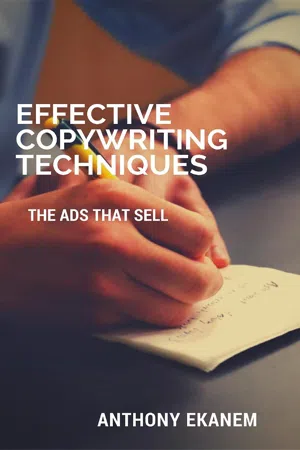
- 51 pages
- English
- ePUB (mobile friendly)
- Available on iOS & Android
About this book
Is it something to be regarded as a work of beauty or art? Is it clever slogans or amusing prose? Or is it workmanship to be judged for an award or recognition? It's none of the above. Advertising is salesmanship multiplied. Nothing more. And advertising copy, or copywriting, is salesmanship in print. The purpose of a copywriter's job is to sell. Period. The selling is accomplished by persuasion with the written word, much like a television commercial sells (if done properly) by persuading with visuals and audio. As Claude Hopkins wrote in his timeless classic, Scientific Advertising: To properly understand advertising or to learn even its rudiments, one must start with the right conception. Advertising is salesmanship. Its principles are the principles of salesmanship. Successes and failures in both lines are due to like causes. Thus every advertising question should be answered by the salesman's standards. The only purpose of advertising is to make sales. It is profitable or unprofitable according to its actual sales. It is not for general effect. It is not to keep your name before the people. It is not primarily to aid your other salesmen. Treat it as a salesman. Force it to justify itself. Compare it with other salesmen. Figure its cost and result. Accept no excuses which good salesmen do not make. Then you will not go far wrong.The difference is only in degree. Advertising is multiplied salesmanship. It may appeal to thousands while the salesman talks to one. It involves a corresponding cost. Some people spend $10 per word on an average advertisement. Therefore every ad should be a super-salesman. A salesman's mistake may cost little. An advertiser's mistake may cost a thousand times that much. Be more cautious, more exacting, therefore. A mediocre salesman may affect a small part of your trade. Mediocre advertising affects all of your trade. These points are as true today as they were when they were written nearly one hundred years ago!
Frequently asked questions
- Essential is ideal for learners and professionals who enjoy exploring a wide range of subjects. Access the Essential Library with 800,000+ trusted titles and best-sellers across business, personal growth, and the humanities. Includes unlimited reading time and Standard Read Aloud voice.
- Complete: Perfect for advanced learners and researchers needing full, unrestricted access. Unlock 1.4M+ books across hundreds of subjects, including academic and specialized titles. The Complete Plan also includes advanced features like Premium Read Aloud and Research Assistant.
Please note we cannot support devices running on iOS 13 and Android 7 or earlier. Learn more about using the app.
Information
Chapter 1
What is Advertising?
Chapter 2
Your Advertising Focus
Table of contents
- Chapter 1
- Chapter 2
- Chapter 3
- Chapter 4
- Chapter 5
- Chapter 6
- Chapter 7
- Conclusion